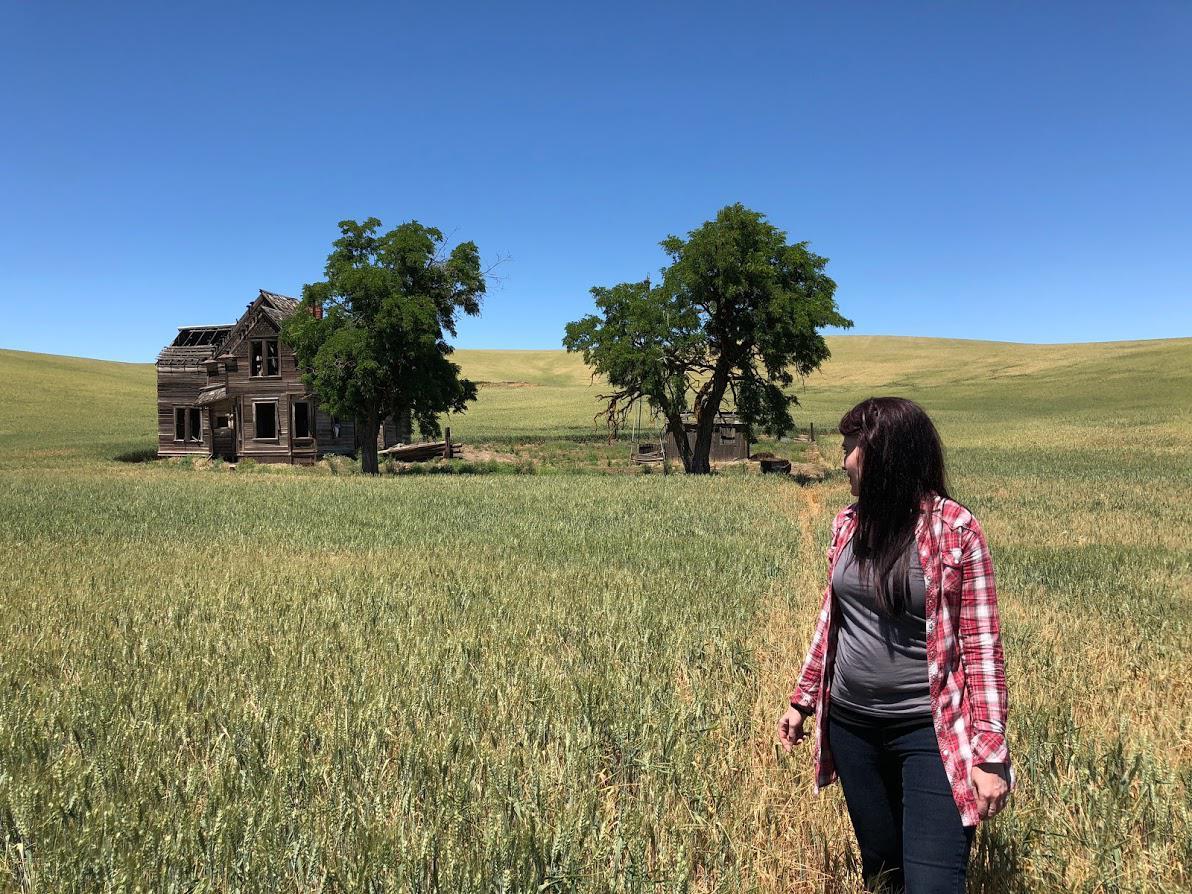Rumor had spread that time might be running out for the Nelson House.
The Charles E. Nelson House was a weathered clapboard farmhouse, tucked up in the rolling wheat fields of Oregon’s high plains. With two gnarled black locust trees beside it and a collapsing wagon in front, the Nelson House captured people’s imaginations, evoking questions: Who once lived there? Why had they left? How long had the house been there and how much longer would the house stand?
“It takes the viewer by surprise when it comes in to view, sitting alone in a little swale along Emerson Loop Road, beaten and tattered to the point of collapse, but still somehow it remains standing,” wrote Theresa Peterson of the nearby town Dufur. “Even in its precarious position it is still stately. Out of place in the middle of a wheat field but yet it belongs, as a testament to the past.”
The details of the woodwork, the broken bric-a-brac and gingerbread shakes of the Queen Anne Victorian, told the story of turn-of-the-century craftsmen who had cut and driven each piece of wood with skill and intention. A sturdy place to shoulder the winds and the snow, and to shade the hot summer sun. Two stories tall with four bedrooms, a parlor, dining room, kitchen — it was a space shaped to raise a pioneering family.
It had stood, folks guessed, at least a century. Few knew when the last residents moved out. Most who saw it came from afar — photographers especially. The solitary home was widely considered the most-photographed homestead in Oregon.
A photograph of the Nelson House first prompted Danielle Denham to drive from her home in Portland to see it — and photograph it — for herself.
That first experience at the Nelson House inspired her to seek out more abandoned structures and remnants of past lives lived in the remote pockets of Oregon. She set out any time she could, hopping in her car with her camera to head down long and lonely back roads, deliberately letting herself get lost so she could happen upon places long ago forgotten.
For the next five years, Denham crisscrossed the state, developing her craft and building a visual record of abandoned places. She set out to photograph every one-room schoolhouse still standing in Oregon. She helped launch a Facebook group, Abandoned Oregon, as a community platform to share and celebrate photos of such places.
“We really had no idea how big it would get, but it is up to 24,000 members now,” Denham said as she sat at her laptop, the website pulled up. She scrolled through the recent postings: schoolhouses, cars rusting in brambles, even “a bridge to nowhere.” She chuckled.
“I think from a photographer's aspect, it's the aesthetic of these places,” she explained. “The peeling paint and the rust and the decay. It's visually very beautiful.”
“Then there's some sadness, too,” she added. “This is also a place where people can share places that have been torn down. This might be their only opportunity to still see one of these buildings in existence because tomorrow it might be gone.”
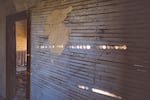
Capturing light inside the Nelson House, Danielle Denham sees beauty in decay.
Danielle Denham
By spring of 2018, rumors on the Abandoned Oregon site and word of mouth within the photo community was that the fate of the most-photographed (and arguably most beloved) Nelson House farmstead was uncertain.
The threat: the photographers themselves.
The Nelson House had become too popular.
Although the primary community rule of the Abandoned Oregon site is not to reveal locations, the secret had gotten out. Social media had spread and hashtaggers had arrived. Some respected the two “No Trespassing” signs nailed to the barbed wire fence. Others didn’t.
Inside the homestead were “glow sticks”— a telltale sign that someone had come to take nighttime shots of the house with the wash of stars behind it.
Luckily there were no signs of graffiti or vandalism. But the rumor was that the landowner was getting sick and tired of trespassers, and that he might level the empty home.
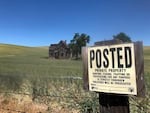
As its popularity increased, so did trespassing, prompting rumors that the Nelson house would be leveled.
Ian McCluskey / OPB
I had seen photos of the Nelson House, and like many others, felt compelled to see it in person. Having stood a century, it seemed it would stand another 100 years. Now the timing felt urgent.
I didn’t want to just show up. In fact, I didn’t actually know which rural road to turn down to find it. I would need two things: a guide to take me there and permission.
On a clear June day, I met up with Denham. I had a surprise for her. With me was 90-year-old Ellen Simmons. She had firsthand knowledge of the Nelson House to share.
We stepped through the barbed wire fence and across the wheat that was already knee-high, ripening for harvest.
In previous visits, Denham had taken photos from the road. Like many of her friends and colleagues, she’d respected the no-trespassing signs. For the first time, she had permission to get up close.
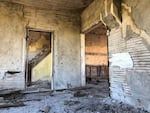
A rare peek inside the Nelson House
Ian McCluskey / OPB
The house once belonged to Simmons’ aunt and uncle, Orma and Charles Nelson. The land had first been homesteaded in the late 1800s, and then passed through several owners until newlywed Charles and Orma made it their home in 1927.
Simmons had a small faded photo to share with us. In it she is standing on the front porch of the house. She’s 1 year old. On the back is written: “November, 1929."
Just a week or so before the photo was snapped, the stock market crashed, plunging the nation into the Great Depression.
Charles Nelson didn’t just work his own land. He also kept several other farms in the area going, as well. When he needed to tend to another, Simmons’ grandparents moved to the Nelson House to keep it running. They had chickens for eggs and meat, a cow or two for milk. It was Simmons’ job to sit on a footstool in the kitchen and churn the butter.

Ellen Simmons holds a photo of herself as a child on the front porch of the Nelson House in 1929.
Ian McCluskey / OPB
We stepped gingerly into the back door, which led into the kitchen. The kitchen floor was linoleum, and we could still see pieces of it clinging to the floorboards. “I can remember where the linoleum had worn through,” Simmons recalled. “And Grandma would nail down the tops of tin cans, so they wouldn't wear out anymore.”
Simmons pointed to the corner. “There used to be a bathtub there. Aunt Orma had it covered with some kind of a cover and then pillows on there. It had a pad on it so Uncle Charles or Grandpa could lay down on it and rest after work.”
We stepped into a large, empty room. Our feet crunched on plaster that had fallen from the ceiling.
My eyes saw the exposed lath, the weathered wainscoting. Simmons saw the place her grandma once sewed quilts. She saw where the large table used to be that they’d gather around for meals.
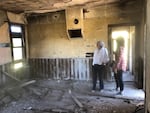
Ellen Simmons leads photographer Danielle Denham on a personal tour of the Nelson House.
Ian McCluskey / OPB
“I can remember each room, where furniture was and where pictures were hung, where Grandpa was shaving. He had his mirror hanging on the wall and I would watch him shave,” she recounted. “This old house will never have those things again.”
The wind made a low whistle through the warped window sashes. Through the window, we saw the sun turning the wheat fields golden and illuminating the snow-capped summit of Mount Hood in the distance.
Denham and Simmons sat together in a windowsill of the Nelson House. For Denham, this was the moment she’d longed for. So many times she had tiptoed into abandoned places, and could only guess at the stories.
“If I had come in here by myself, I wouldn't know any of this amazing history,” she told Simmons. “And so having you here is just a really special thing to be able to tell me all of this history and tell me what happened here, what your life was like.”
Both women paused and listened to the wind, and the gentle creak of the old boards.
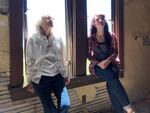
Ellen Simmons and Danielle Denham take a moment to listen to the sounds inside the empty Nelson House
Ian McCluskey / OPB
Just then a pickup pulled up and a man got out. He walked briskly toward us, and we got that panicky sensation of being in trouble.
The man was Will Ford, a wheat farmer who works this land. I’d spoken to him on the phone and gotten the permission to enter his property. When this was confirmed, he relaxed.
I got a chance to ask him directly: Are you considering tearing down the Nelson House?
He shook his head. “I’d sure hate to see it gone,” he said. Although the trespassing had been disrespectful, it actually wasn’t his biggest concern. More, he worried that someone might get hurt. Especially if they ventured into the house’s second story.
“Just be careful,” he said, as he turned quickly as he came, and headed back across his wheat field to his truck. He had work to do.

Ellen Simmons visits her childhood home, the Nelson house, for the last time
Danielle Denham
Although the rumor of the house getting torn down wasn’t true, we still felt an urgency to our visit.
“Whatever happens to it, this could be my last chance to be here,” Denham said as she snapped photos. “This could be my last chance to document this piece of history."
“Well I am certainly glad I got to come because this is probably the last time I'll ever see this house again,” said Simmons.
The setting sun peeked through the roof. Wind had peeled back the cedar shakes, leaving only the weathered battens. As day turned to dusk, it was time to head off. We said goodbye to the Nelson House. We didn’t know it truly would be the last time.
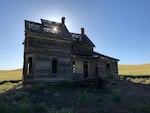
the setting sun peaks through the roof of the Nelson House
Ian McCluskey / OPB
Just a few weeks after our visit, the Substation Fire broke out near The Dalles. The high winds of the Columbia River Plateau quickly fanned the flames across the dry wheat, tall and yellow at the peak of its harvest. It claimed more than 78,000 acres and took the life of a farmer as he tried to stop the fire's spread. It also took the Nelson House.
Just two days later, as the blackened soil still smoldered, Denham returned to the nook in the hills where the Nelson House had stood. She found only a heap of ashes.
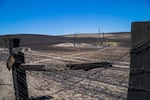
All that was left of the iconic Nelson House after the Dalles Substation fire, 2018.
Danielle Denham
Back in Portland, Denham sorted through her photos, the last records of the Nelson House. Tiny details like doorknobs and peeling paint, the reflection of sunlight slanting on cracked plaster.
“I really enjoyed being able to come back and see these shots of Ellen and just how profound it was for me and her to be standing there. She was really an amazing woman to be able to talk to. What a beautiful person.”
She scanned through the thumbnails of images. “I really like these ones of her in the wheat field. I imagine her as a little girl maybe running through this yard.”
I recalled our last moments at the Nelson House, stepping out of it, and turning back to look at it. “What would you like to tell this house before it's gone?” I had asked Simmons.
She paused to consider, and then said simply: “It was a good house. I loved the old house.”
As we left the Nelson House the last time, we stopped to catch it from the most famous photographic vantage point, and how it will now always be fixed in time: the gnarled tree, the collapsed wagon in the foreground, the house, and hills behind, rolling off into a vastness of open land.
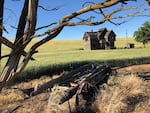
An icon of an era, the Nelson House as it will be remembered in photographs.
Ian McCluskey / OPB
Hear Danielle Denham's interview with OPB "Weekend Edition" host John Notarianni in the audio player below.
